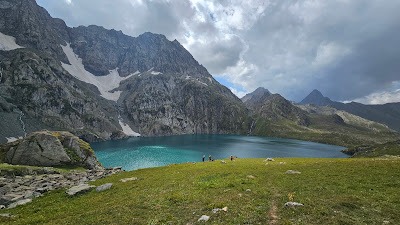
Image Source: Sudeep gowda
About Gangbal Lake
At an elevation of 3,575 meters, Gangabal is a pristine lake located at the base of the majestic Harmukh mountain. In the Ganderbal district, the lake is revered both for its scenic beauty and spiritual significance. It attracts pilgrims, trekkers, and nature lovers. Crystal clear water, a meadow dotted with wildflowers, and the giant presence of Harmukh Peak make Gangabal Lake one of the most beautiful high-altitude lakes in the Himalayas.
Geography and Natural Setting
Gangabal Lake lies on the northeastern slopes of Mount Harmukh, which stands tall at 5,142 meters (16,870 feet). Glacial in origin, the lake is primarily fed by the melting snow from the surrounding peaks and glaciers.
The lake is part of the Sind River basin, which eventually joins the mighty Jhelum River. Gangbal spans around 2.5 kilometres in length and over 1 kilometre in width, making it one of the largest alpine lakes in the Kashmir Valley.
Flora and fauna
The region around Gangabal is rich in alpine flora and fauna. During summer, the meadows surrounding the lake come alive with colourful flowers like blue poppies, anemones, and edelweiss. Shepherds from nearby villages often bring their flocks to graze in these highland pastures during the warmer months.
Mythology and Cultural Significance
Much deep mythological and religious significance is associated with the Gangbal lake. It is often regarded as the abode of Lord Shiva and is sometimes referred to as the “Ganga of Kashmir.” The name “Gangbal” is believed to derive from “Ganga-Bal,” with “Ganga” symbolising the sacred River Ganga and “Bal” meaning strength or source. Thus, it is revered as a Himalayan counterpart to the Ganges.
One of the most important spiritual associations is the belief that Harmukh is the Kailash of Kashmir, and Gangbal is the Gangotri equivalent. According to legend, sages and saints used to meditate in the region, considering it a powerful spiritual seat.
Harmukh-Gangbal Yatra
Each year, Kashmiri Pandits undertake a religious pilgrimage called the Harmukh-Gangbal Yatra, which typically takes place in August and involves performing rituals and immersing ashes of the departed in the holy waters, much like in the Ganges. Despite political and logistical challenges, this pilgrimage continues to be a key cultural and religious tradition for the community.
How to Reach Gangabal Lake
Reaching Gangabal Lake involves a combination of road travel and a high-altitude trek, making it a favorite among seasoned trekkers and adventure enthusiasts.
By Road:
The journey begins from Srinagar, which is well connected by road and air.
From Srinagar, you travel approximately 50 km by road to Naranag, a small village in the Ganderbal district. The route passes through Ganderbal town and offers scenic views of rural Kashmir.
By Trekking Route (Naranag to Gangbal):
The trek from Naranag to Gangbal is around 15-18 kilometers, usually completed in two days (one way).
The trail starts from Naranag, ascends through pine forests, rocky ridges, and alpine meadows such as Butshree and Trunkhol, before finally reaching Gangbal.
A night halt is often made at Trunkhol Meadow, where trekkers camp amidst vast grassy stretches surrounded by pine trees.
The last stretch from Trunkhol to Gangbal passes near Nundkol Lake, a stunning turquoise lake lying just below Gangbal. The two lakes are connected via a small stream.
The difficulty level of the trek is moderate to challenging due to steep ascents and unpredictable weather conditions.
Alternate Trekking Option
Gangabal is also part of the Kashmir Great Lakes Trek, one of India’s most iconic high-altitude treks. In this route, trekkers reach Gangbal on the final leg after passing through lakes like Vishansar, Kishansar, Gadsar, and Satsar.
Best Time to Visit
The ideal time to visit Gangabal Lake is from late June to mid-September, when the snow has melted, the trekking trails are open, and the weather is relatively stable. During this period, the lake is surrounded by lush green meadows, and the skies are mostly clear, offering dramatic reflections of Harmukh in the water.
Winter visits are not recommended, as the entire region remains buried under heavy snow, and access routes are blocked.
